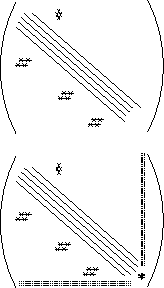




Next: 9.5.2 Design Overview
Up: LU Factorization of
Previous: LU Factorization of
The topic of this section is the implementation and concurrent
performance of sparse, unsymmetric LU factorization for medium-grain
multicomputers. Our target hardware is distributed-memory,
message-passing concurrent computers such as the Symult s2010 and
Intel iPSC/2 systems. For both of these systems, efficient cut-through
wormhole routing technology provides pairwise communication
performance essentially independent of the spatial location of the
computers in the ensemble [Athas:88a]. The Symult s2010 is a
two-dimensional, mesh-connected concurrent computer; all examples in
this paper were run on this variety of hardware. Message-passing
performance, portability, and related issues relevant to this work are
detailed in [Skjellum:90a].

Figure 9.11: An Example of Jacobian Matrix Structures. In
chemical-engineering process flowsheets, Jacobians with main-band
structure, lower-triangular structure (feedforwards), upper-triangular
structure (feedbacks), and borders (global or artificially restructured
feedforwards and/or feedbacks) are common.
Questions of linear-algebra performance are pervasive throughout scientific
and engineering computation. The need for high-quality, high-performance
linear algebra algorithms (and libraries) for multicomputer systems therefore
requires no attempt at justification. The motivation for the work described
here has a specific origin, however. Our main higher level research goal is
the concurrent dynamic simulation of systems modelled by ordinary
differential and algebraic equations; specifically, dynamic flowsheet
simulation of chemical plants (e.g., coupled distillation columns)
[Skjellum:90c]. Efficient sequential integration algorithms solve
staticized nonlinear equations at each time point via modified Newton
iteration (cf., [Brenan:89a], Chapter 5). Consequently, a
sequence of structurally identical linear systems must be solved; the
matrices are finite-difference approximations to
Jacobians of the staticized system of ordinary
differential-algebraic equations. These Jacobians are large, sparse, and unsymmetric for our
application area. In general, they possess both band and significant
off-band structure. Generic structures are depicted in
Figure 9.11. This work should also bear relevance to
electric power network/grid dynamic simulation where sparse,
unsymmetric Jacobians arise, and elsewhere.





Next: 9.5.2 Design Overview
Up: LU Factorization of
Previous: LU Factorization of
Guy Robinson
Wed Mar 1 10:19:35 EST 1995





